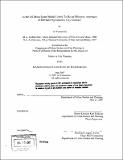Is the US Main Street model likely to be an effective approach to revitalizing Japanes city centers?
Author(s)
Yamamoto, Ai, M.C.P. Massachusetts Institute of Technology
DownloadFull printable version (12.81Mb)
Alternative title
Is the United States Main Street model likely to be an effective approach to revitalizing Japanese city centers
Other Contributors
Massachusetts Institute of Technology. Dept. of Urban Studies and Planning.
Advisor
Karl Seidman.
Terms of use
Metadata
Show full item recordAbstract
As in the United States in the 1970s, a decline of city centers is a social issue in Japan today. Although the Japanese government has attempted to address the issue since the late 1990s, little accomplishment can be seen to date. Thus, it is crucial to find a different approach - different from the conventional top-down approach in Japan. This study focuses on the Main Street Program, which is the most widely used community-driven approach in the United States. This study first discusses why the Main Street approach is promising for Japanese downtown revitalization, looking at the Main Street Program itself and distinguishing it from other downtown revitalization strategies in the United States. This study then shows Japanese economic and urban policy trends at the national and the local levels: at the national level, a reform from top-down to bottom-up is occurring, and at the local level, municipalities are struggling to enhance civic participation in decision-making and actions. Although Town Management Organizations (TMOs) were introduced with enactment of the first City Center Invigoration Law in 1998, they were ineffective because of a lack of comprehensiveness in project planning and implementation, an involvement wide range of stakeholders, a shortage of managers, and an absence of a nationwide support system. The Main Street Program could remedy these limitations. Second, this study explores how Japan can start the Main Street model, drawing upon a story by the pioneer of the program and cases of Japanese original community-driven revitalization efforts. The story of the pioneer shows the social environment in the United States in the 1970s. The story also reveals how the Main Street Program developed and disseminated in the whole United States. On the other hand, though Japanese revitalization efforts show stand-alone development, they have components similar to those developed in the Main Street Program. Finally, this study offers a way to systematize the Japanese version of the community-driven downtown revitalization approaches with consideration of the strengths of both an American systematized model and Japanese unique revitalization contexts.
Description
Thesis (M.C.P.)--Massachusetts Institute of Technology, Dept. of Urban Studies and Planning, 2007. Includes bibliographical references (p. 177-181).
Date issued
2007Department
Massachusetts Institute of Technology. Department of Urban Studies and PlanningPublisher
Massachusetts Institute of Technology
Keywords
Urban Studies and Planning.